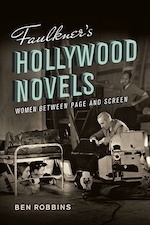Today, we are happy to bring you our conversation with Ben Robbins, author of Faulkner's Hollywood Novels: Women between Page and Screen
What inspired you to write this book?
Before I started work on this project, I remember watching The Big Sleep (1946) one evening on TV, and being surprised to see William Faulkner credited as one of the screenwriters. I was fascinated to learn that this author of highly experimental modernist prose had also been a Hollywood screenwriter who worked on a film noir adaptation of a Raymond Chandler novel. I dug a bit deeper and discovered the sheer range of film projects Faulkner contributed to in Hollywood between the 1930s and 1950s, from romances and melodramas to horror and war films. In my book, I wanted to reconcile this large body of film work with Faulkner’s fiction and to reveal how Hollywood shaped him as a writer over this period.
What did you learn and what are you hoping readers will learn from your book?
Faulkner never wrote any fiction set in Hollywood or Los Angeles, apart from one short story called “Golden Land” (1935). From this knowledge alone, you might think that Hollywood played only a marginal role in Faulkner’s prose. But when I started to read Faulkner’s screenplays alongside his novels, I discovered that Hollywood was everywhere in his fiction after he began working for the studios in 1932, as he repeatedly borrows genre conventions, characters, and techniques from his film work. I hope readers will learn that Faulkner did in fact produce “Hollywood novels,” which processed his experiences as a screenwriter in non-Californian settings. Although these texts weren’t actually set in the film community, they are nevertheless in continual and close dialogue with his screenwriting.
What surprised you the most in the process of writing your book?
Although many of Faulkner’s screenplays have now been published, I was surprised to find a lot of Faulkner’s screenwriting in the archives that is not in the public domain and has been little discussed. Just one example is a vampire horror film written by Faulkner in the mid-1940s called “Dreadful Hollow,” which features a lesbian, Dracula-type character. In navigating this material, I was most struck by the evolution of Faulkner’s female characters in his prose. I argue that many of these characters became increasingly “filmic” as a result of his Hollywood work. While Faulkner undoubtedly reinforced female stereotypes in his Hollywood pictures, he also questioned them in his writing and in fact advanced popular images of women in genres such as film noir and melodrama.
What’s your favorite anecdote from your book?
I have a favorite story from the set of To Have and Have Not (1944). Faulkner worked on this film adaptation of Ernest Hemingway’s 1937 novel, an adventure picture starring Humphrey Bogart and Lauren Bacall. Faulkner had some trouble writing dialogue for Bogart. He produced drafts of speeches that were much too long and elaborate to suit the Bogart persona, a tough, laconic, and cynical figure. During his time as a screenwriter for To Have and Have Not, Faulkner would bring new dialogue onto set for the actors. On one occasion, after presenting some of this fresh material to Bogart, the actor responded, “Bill, how am I supposed to say all that?” I think we call all sympathize with Bogart after reading Faulkner’s long sentences!
What’s next?
I’m looking forward to introducing my new book at events and conferences in Austria, Germany, and the US this year. At the moment, I’m working on a second book about early twentieth-century queer exile writers as part of a four-year research project I’m leading at the University of Innsbruck in Austria. So I’m still working on modernist authors from the US, even if Faulkner isn’t directly part of this project. I have a fellowship next winter at the Harry Ransom Center in Austin, Texas to do some research on exile writers in Italy and Morocco. I know they also have a pretty extensive Faulkner collection, so who knows what I might find next!





